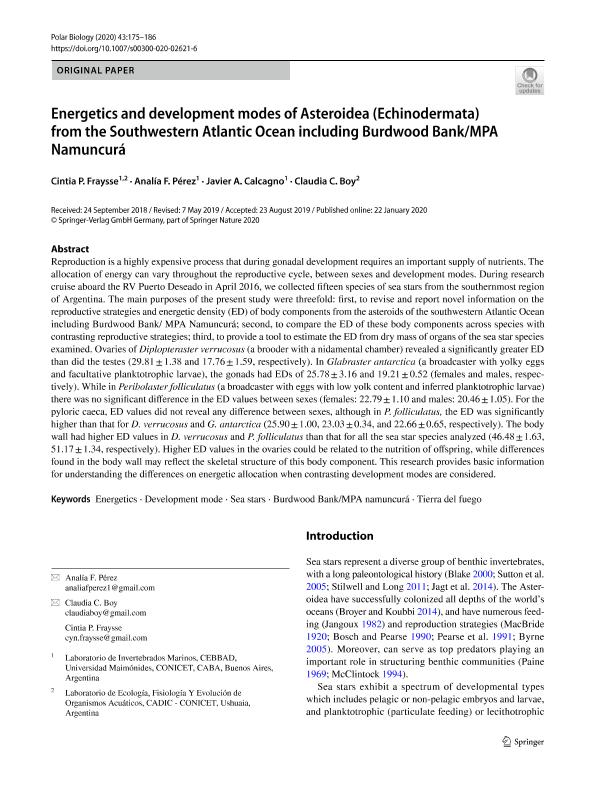Artículo
Energetics and development modes of Asteroidea (Echinodermata) from the Southwestern Atlantic Ocean including Burdwood Bank/MPA Namuncurá
Fecha de publicación:
02/2020
Editorial:
Springer
Revista:
Polar Biology
ISSN:
0722-4060
Idioma:
Inglés
Tipo de recurso:
Artículo publicado
Clasificación temática:
Resumen
Reproduction is a highly expensive process that during gonadal development requires an important supply of nutrients. The allocation of energy can vary throughout the reproductive cycle, between sexes and development modes. During research cruise aboard the RV Puerto Deseado in April 2016, we collected fifteen species of sea stars from the southernmost region of Argentina. The main purposes of the present study were threefold: first, to revise and report novel information on the reproductive strategies and energetic density (ED) of body components from the asteroids of the southwestern Atlantic Ocean including Burdwood Bank/ MPA Namuncurá; second, to compare the ED of these body components across species with contrasting reproductive strategies; third, to provide a tool to estimate the ED from dry mass of organs of the sea star species examined. Ovaries of Diplopteraster verrucosus (a brooder with a nidamental chamber) revealed a significantly greater ED than did the testes (29.81 ± 1.38 and 17.76 ± 1.59, respectively). In Glabraster antarctica (a broadcaster with yolky eggs and facultative planktotrophic larvae), the gonads had EDs of 25.78 ± 3.16 and 19.21 ± 0.52 (females and males, respectively). While in Peribolaster folliculatus (a broadcaster with eggs with low yolk content and inferred planktotrophic larvae) there was no significant difference in the ED values between sexes (females: 22.79 ± 1.10 and males: 20.46 ± 1.05). For the pyloric caeca, ED values did not reveal any difference between sexes, although in P. folliculatus, the ED was significantly higher than that for D. verrucosus and G. antarctica (25.90 ± 1.00, 23.03 ± 0.34, and 22.66 ± 0.65, respectively). The body wall had higher ED values in D. verrucosus and P. folliculatus than that for all the sea star species analyzed (46.48 ± 1.63, 51.17 ± 1.34, respectively). Higher ED values in the ovaries could be related to the nutrition of offspring, while differences found in the body wall may reflect the skeletal structure of this body component. This research provides basic information for understanding the differences on energetic allocation when contrasting development modes are considered.
Archivos asociados
Licencia
Identificadores
Colecciones
Articulos(CADIC)
Articulos de CENTRO AUSTRAL DE INVESTIGACIONES CIENTIFICAS
Articulos de CENTRO AUSTRAL DE INVESTIGACIONES CIENTIFICAS
Articulos(SEDE CENTRAL)
Articulos de SEDE CENTRAL
Articulos de SEDE CENTRAL
Citación
Fraysse, Cintia Pamela; Pérez, Analía F.; Calcagno, Javier Ángel; Boy, Claudia Clementina; Energetics and development modes of Asteroidea (Echinodermata) from the Southwestern Atlantic Ocean including Burdwood Bank/MPA Namuncurá; Springer; Polar Biology; 43; 2; 2-2020; 175-186
Compartir
Altmétricas




